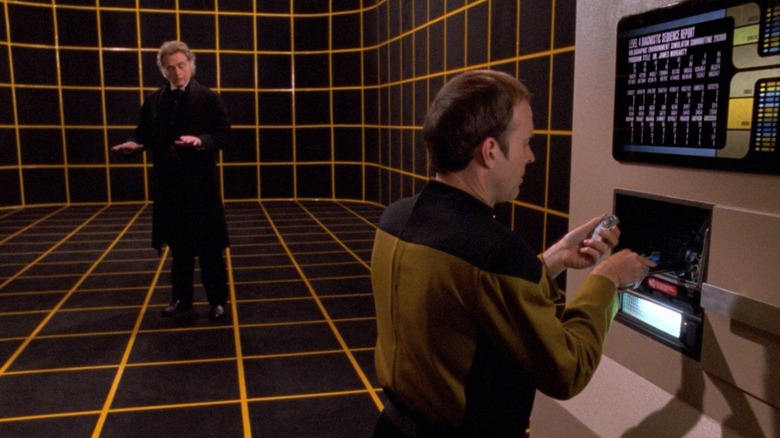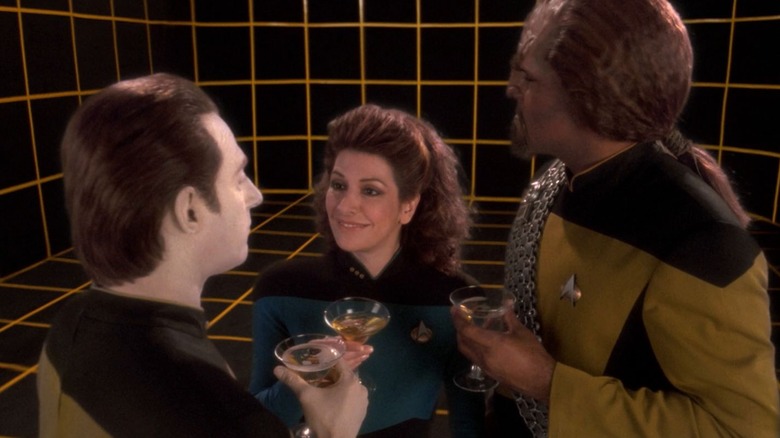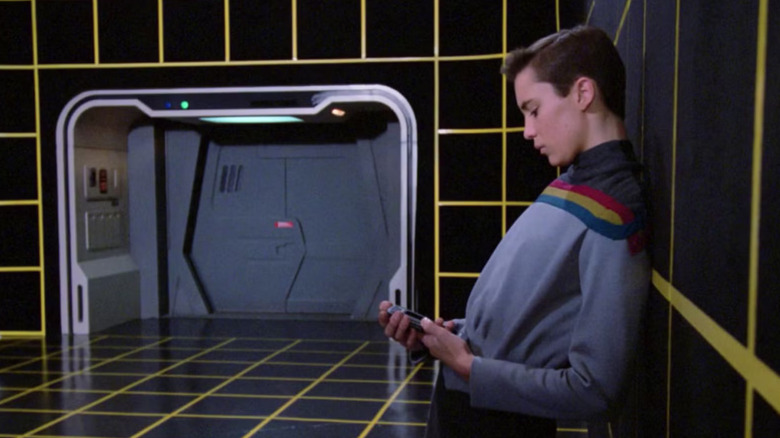Star Trek's Gene Roddenberry Had One Condition To Allow The Holodeck
We may receive a commission on purchases made from links.
The holodeck is one of the more fantastical pieces of technology on "Star Trek." The holodeck, for neophytes, is a specialized room on the U.S.S. Enterprise that uses a grid of holographic cameras to simulate an artificial, fully immersive environment. Force field technology allows the simulations to take on tactile properties, and a special force field "treadmill" allows users to go on long walks while staying in place. There is also a matter replicator worked into the holodeck, so people can eat real food on the holodeck, or even replicate souvenirs to take home.
If such a technology existed in real life, of course, everyone would own one, and no one would ever leave. All the free food and fantasy environments my twisted imagination can conjure? Yeah, I'll be in the holodeck if you need me.
A holodeck-like technology first appeared on Trek in the "Star Trek: The Animated Series" episode "The Practical Joker" (September 21, 1974). On that episode, it was just called the Recreation Room, but it created holographic environments. The word "holodeck" wouldn't be used until "Star Trek: The Next Generation" in 1987.
As it happens, the holodeck was inspired by some very real technology. Back in 1964, before "Star Trek" even aired, a man named Gene Dolgoff, an expert in optics, holography, and 3-D technology, was pioneering projection and new imaging machines. In 1973, Dolgoff was running an optics lab and was invited to a scientific conference in Prague to deliver a brand-new paper he wrote about new innovations in the field. One of the attendees was a woman named Melanie Toyofuku, who, as it happens, was friends with "Star Trek" creator Gene Roddenberry. Toyofuku arranged a meeting of the Genes, and Dolgoff had a chance to share his holographic ideas with Roddenberry.
Dolgoff recalled his meeting in a 2014 interview with StarTrek.com. He also recalled Roddenberry's rule for incorporating said tech into "Star Trek" proper: It couldn't be too silly, and had to have some basis in what could, theoretically, actually exist in the future.
Gene Dolgoff came up with the word 'holodeck'
Dolgoff said that he was taken by Toyofuku to meet with Gene Roddenberry and his wife Majel Barrett back at a New York hotel. There, Dolgoff set up a large-scale demonstration for Roddenberry, using holographic prints and some lasers, hoping to show Roddenberry around. Dolgoff was a Trekkie going way back, and liked the idea of introducing a rudimentary (but advanced) real-life technology into the fictional world of "Star Trek." He wanted to see what optic technology would look like in several hundred more years. Dolgoff essentially pitched the whole idea of a holodeck on that day, saying:
"[I]n the future, but you could make a holographic environment in which people could interact with the objects and the scenes and everything, and create a recreation room, a training room, an area that could be for entertainment. We kind of agreed on the name 'holodeck.' I put the holography part in there."
And it seems that Roddenberry liked the idea. Indeed, Roddenberry's mental wheels were turning during the entire demonstration. There were concerns, however. Roddenberry felt that the fantastical element of a holodeck might make it too silly. By Dolgoff's recollection:
"[Roddenberry] was totally into it. He said, 'This is along the lines of what I was trying to think about. I just had no idea how this could be ... or could this be?' He said, 'I didn't want to be so ridiculous that it wasn't right and there wouldn't be something like this in the future at all.' I said, 'No, you're on the right track completely. This is exactly what will happen,' and I explained, technically, how it would work."
Once the technology was explained, Roddenberry suddenly felt that a holodeck was less silly. After all, this was 1973, and they were already on the cusp of realistic 3D images. Just throw in fantastical forcefields and a holodeck is born. It's not so farfetched. While the holodeck would lead to some ridiculous episodes of "Star Trek," it did meet Roddenberry's one condition: It always felt just plausible enough, and the technology itself was never silly.
Gene Dolgoff never get credit for his idea
Roddenberry, as mentioned above, started using the word "holodeck" in the mid-1980s, and holodecks became a major part of the "Star Trek" franchise. They allowed Trek writers to add a little visual variety to the sci-fi series, sometimes providing 1930s detective stories or pastoral medieval scenes. Sex-based holosuites were a big part of "Star Trek: Deep Space Nine," and one of the main characters on "Star Trek: Voyager" was an intelligent hologram. None of these things would have happened without Dolgoff's ideas.
Sadly, by the time "Next Generation" began airing, Roddenberry and Dolgoff had already lost contact. Dolgoff was never consulted for anything after 1973. In a second part of the StarTrek.com interview, he revealed that he was never credited or compensated for introducing Roddenberry to holodecks. Dolgoff wasn't angry enough to take any kind of legal action, but he was miffed that Roddenberry didn't mention his name in a script. He said:
"That's the way it goes, often; you come up with something and then you don't get any recognition for it. I watched everything. I never missed an episode of any of the 'Star Trek' franchises. I loved all the holodeck stuff. I thought it was really great and I really enjoyed it. I just wish I'd had more of an interaction [with the franchise]. I was always wishing I'd be like the guy they said invented the warp drive."
That last comment is merely a plea for a "Star Trek" writer to mention him as the inventor of the holodeck. He didn't necessarily need a guest spot. Of course, there are new "Star Trek" shows in production, so there's still a chance to mention, say, the Dolgoff Emitter, or the Dolgoff Holography Center as an adjunct of Starfleet. It would only be fair. Dolgoff is currently working at Holobeam Technologies.


